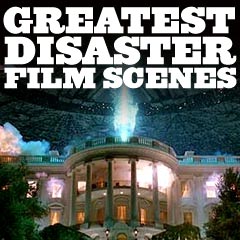
|
Film Scenes 2000s |

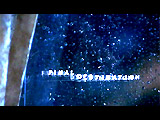
|
Final Destination (2000) A long series of five supernatural, teen horror films - the Final Destination films (a financially-successful franchise) premiered in 2000 and lasted for 11 years until 2011. The first one had a tagline that explained the basic premise of each film:
Each film included grisly, creatively imaginative, contrived, unexpected and improbable deaths of the major characters, usually in mass-casualty events. The few survivors prolonged their lives for only a short time. Later in this film (and the sequels that followed), those who had escaped death were killed in a series of bizarre, improbably, but inventive Rube Goldberg-like accidents.
In the first installment of the series, high-school senior and psychic airline passenger Alex Browning (Devon Sawa) had a very real, frightening, two-minute premonition of a 747 airplane crash that he was on after take-off - bound for Paris (from NY). In a sweat and panic, he deplaned with others from Volee Airlines Flight 180, and then described his "bad f--king dream":
Then, as the group of teens and adults were in the waiting area of the terminal (and engaged in a scuffle), the plane actually took-off behind them at 9:25 pm within view - and exploded over the Atlantic Ocean, shattering windows in the terminal as it passed by. All 287 passengers were feared dead, including a class of forty students and four teachers from Mount Abraham HS in south-east New York en route to Paris on a field trip. The crash was controversially based on the tragic TWA 800 crash in July 1996. It even used news footage from that crash as stock footage for a later TV news report. |
 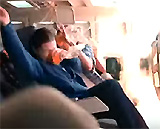 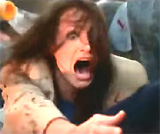 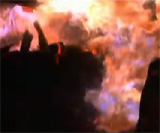 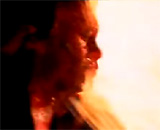 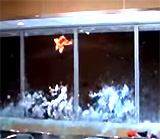 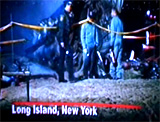
|
||||||||||||||||||||||
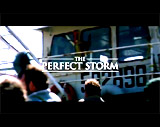
|
The Perfect Storm (2000) Director Wolfgang Petersen's downbeat, nihilistic true story was about an intense weather event in the North Atlantic - a killer "perfect" storm. It was based on Sebastian Junger's best-selling 1997 book "The Perfect Storm: A True Story of Men Against the Sea" - and a real-life event - the remnants of tropical Hurricane Grace in late October and early November 1991 that collided with a massive Great Lakes cold front off the Atlantic Coast. It was a combination of a stereotypical 70s disaster film, with an ensemble cast melodramatically involved in a dangerous occupation. The big-budget action-adventure received only two Academy Award nominations: Best Sound and Best Visual Effects (defeated by Gladiator (2000)). The authentic-looking storm-tossed water sequences (from ILM's CGI digital effects department) were aided by wave machines, water cannons, and two huge dump tanks. In one incredible aerial shot, the camera plunged into the spiraling clouds of Hurricane Grace and into the Atlantic Ocean below. The dramatic action-thriller told about the Andrea Gail, a North Atlantic fishing troller from Gloucester, Massachusetts, and its crew of commercial fishermen who were caught in the fall of 1991 in the late-season after two weeks at sea. The four crew members (with no survivors) and others assisting in the rescue were mostly big-name stars:
They were confronted by a violent storm (a confluence of two weather systems and a hurricane) with massive sea swells. The fishing expedition vessel suffered major damage, including a failed refrigeration system, a non-functioning antenna, and a broken stabilizer. The major rogue wave that they had to confront capsized and overturned their vessel. Billy and Bobby bid each other goodbye, after which Bobby swam to the surface (where he drowned), while Billy chose to die within the boat:
|
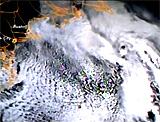  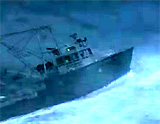 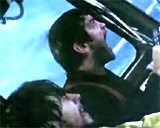 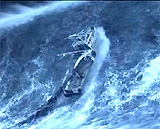 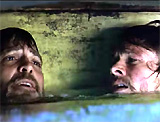
|
||||||||||||||||||||||

|
Vertical Limit (2000) Director Martin Campbell's nail-biting, action-adventure survival thriller, with the tagline: "HOLD YOUR BREATH," told about the exciting and lethally-dangerous sport of mountain-climbing - and mountain rescue. In the excruciatingly-tense opening sequence, three characters in the same family were introduced during a dangerous climb on a steep rock face in Monument Valley. Their adventure ended in the death of the self-sacrificing father, who demanded that his son cut him loose from the bottom of the dangling rope to save his children above him:
As time passed, Peter gave up climbing and became a wildlife-nature photographer, while Annie (who begrudgingly blamed Peter for hastily causing her father's death) carried on as a famous, Sports Illustrated superstar mountain-climber. To set up the survival catastrophe, she was hired by tycoonish (and despicable) Texas billionaire Elliot Vaughn (Bill Paxton) to lead a climbing excursion to the top of the Himalayan peak K2. They were joined by Vaughn's friend, renowned guide-climber Tom McLaren (Nicholas Lea) and Pakistani Ali Nazir. Obvious problems arose during the steep climb - the deterioration of the weather (high winds and an ice storm), avalanches, a cave-in and entrapment in an icy crevasse at 26,000 foot altitude without much oxygen. McLaren was critically-injured (with broken legs and ribs), Ali died, and Annie had a severe case of pulmonary edema. The conclusion of the film involved Peter's assemblage of a rescue mission crew, composed of:
There were multiple problems with the highly-explosive, unstable and volatile cans of nitroglycerin carried by the rescue crew, to blast into the ice cave. Many died during the dangerous rescue effort, including a self-sacrificing Wick (who took Vaughn to his death with him after cutting a rope). A recovering Annie reconciled with Peter at the base camp, along with other survivors Monique and Taylor. |
 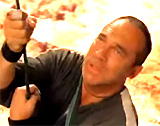 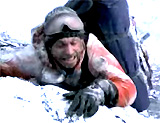 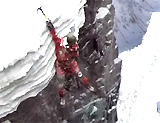 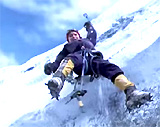 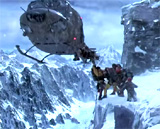 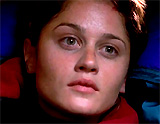
|
||||||||||||||||||||||
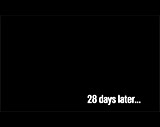
|
28 Days Later... (2002, UK) This post-apocalyptic, low-budget sci-fi horror film from director Danny Boyle (with a script by Alex Garland) opened in a completely deserted London, with haunting views of a virus-ravaged landscape, due to the spread of an experimental, laboratory-bred virus or plague (known as the Rage Virus). A sequel followed -- 28 Weeks Later (2007, UK) by director Juan Carlos Fresnadillo, continuing the events of this film about seven months later. Animal activists had attempted to rescue simian victims from sadistic scientists in the Cambridge Primate Research Center, with disastrous results when the raging, infected animals were set free, bit an activist, and unleashed the infection that soon was rumored to have spread worldwide. The main character, bicycle courier Jim (Cillian Murphy), awoke from a coma in a hospital (he learned it was 28 days following the disaster), and found the hospital and surrounding area completely desolate. He joined a few other survivors in a safe-house (within the London Underground):
Similar to many of George Romero's "Dead" franchise series, the evacuated city had become overrun with roaming bands of crazed, diseased zombies as a result of the infectious blood disorder. There was a suspenseful scene in a tunnel as the group changed a tire and both a swarm of rats and zombies approached. After Mark was bitten and infected - and had to be brutally hacked to death with a machete by Selena, the two met more survivors:
Eventually, the surviving trio (minus Frank who was contaminated with a drop of infected blood in his eye from a bird) reached a rag-tag military outpost (an old mansion) in northern England near Manchester commanded by Major Henry West (Christopher Eccleston), suspected to be power-hungry and mad. The two females were harrassed and needed protection from the sex-hungry military soldiers, who wanted to use them for breeding stock. One zombie, infected soldier Private Mailer (Marvin Campbell), was chained up for experimental purposes. It was revealed that the virus had NOT spread beyond the UK and had not infected mainland Europe. About two months after the outbreak and after escaping the mansion and living in a remote cottage, Selena, Jim, and Hannah spotted a Finnish rescue plane - with the hopeful promise of being saved, but it was likely they were not seen, as Selena wondered in the last line: "Do you think he saw us this time?" |
  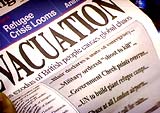  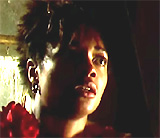
|
||||||||||||||||||||||
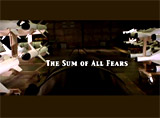
|
This fourth film by director Phil Alden Robinson, an action spy-thriller (not really a disaster film), was based upon writer Tom Clancy's best-selling 1991 novel of the same name - the fourth such novel to be turned into a film. The film was delayed in theatrical showings due to the 9/11 disaster, and heavily edited. The hero in all five of the novels/films was:
The five films in the popular franchise-series were:
This fourth film, set during the Cold War with Russia, featured Ben Affleck as a CIA-recruited analyst named Jack Ryan. He discovered the plot of a Neo-Nazi terrorist group to set off a nuclear bomb (purchased on the black market) in the city of Baltimore during a major professional football competition - a major altercation that could be blamed on Russia and instigate a major war between the two countries. In the sequence, Ryan phoned CIA Director William Cabot (Morgan Freeman) in the crowded stadium. When Ryan eventually delivered his message, "The bomb is in play" somewhere in Baltimore, Cabot ordered the Secret Service agents to get the President out of the stadium. After he was safely evacuated, the bomb detonated (it was hidden in a cigarette vending machine in the stadium's underground parking area). The shockwaves of the mushroom-shaped nuclear blast destroyed much of the city, the President's motorcade of cars was toppled, and Ryan's helicopter crash-landed, although most officials survived. The blast was reported to be from a low-yield device, smaller than the Hiroshima bomb, and it had left a crater a quarter of a square mile around the stadium (ground zero), and other heavily damaged buildings for another quarter mile. |
 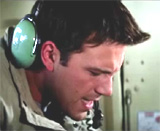 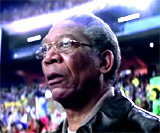 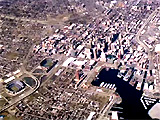 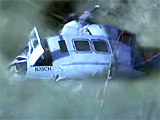 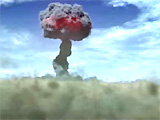
|
||||||||||||||||||||||

|
The Core (2003) This worldwide ecological, sci-fi disaster film was directed by Jon Amiel. It portrayed a very hypothetical scenario in which the unstable Earth's molten core had inexplicably stopped spinning, causing the unleashing of harmful cosmic microwave rays and deadly solar radiation. The tagline was:
A number of disastrous signs that occurred worldwide were related to the problem, signaling a possible end to life on Earth:
As the radiation increased, further disasters such as earthquakes, bridge collapses (a beam directly struck the middle of the Golden Gate Bridge in SF), and super electrical-lightning storms were happening all over the world. A team of scientists, led by Dr. Joshua "Josh" Keyes (Aaron Eckhart), and military officials went on a mission to drill into the core with an ultrasonic laser-driven boring system and detonate nuclear warheads to jump start it back to normal -- a preposterous and entirely unscientific idea. The device in a subterranean vessel-ship dubbed Virgil was made of indestructible material known as "unobtainium." Virgil would be launched into the deepest part of the western Pacific Ocean, known as the Marianas Trench to travel into the Earth's core. Ultimately, after a number of close calls, unforeseen issues, drilling problems and deaths, a series of nuclear explosions successfully restarted the core's rotation. |
 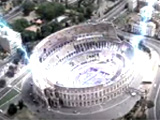 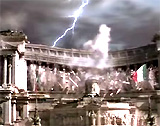 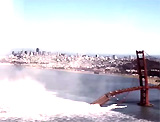 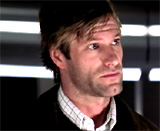 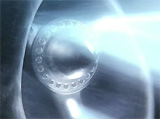 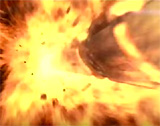 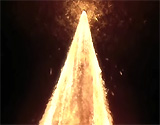
|
||||||||||||||||||||||
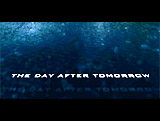
|
The Day After Tomorrow (2004) This quintessential ecological, climate disaster film was another sci-fi thriller from director Roland Emmerich - one in a string of his frequent 'disaster' films (with future sequels planned):
This big-budget blockbuster asked the question in its tagline:
It chronicled the catastrophic climactic after-effects of global warming and the greenhouse effect, bringing about a very rapid Ice Age, prefaced by a series of major natural catastrophes:
The heroic star of the film was paleo-climatologist Jack Hall (Dennis Quaid), who had correctly theorized that changes in the melting rate of polar ice caps had disrupted the North Atlantic weather patterns and the normal pattern of water circulation/flow. Jack made valiant efforts to rescue and save his son Sam (Jake Gyllenhaal), hunkered down with his academic decathlon teammate Laura Chapman (Emmy Rossum), located in Manhattan's New York Public Library. Meanwhile, NYC around them was inundated by freezing temperatures and severe flooding in the subway system and Grand Central Station, and the flood waters threatened to drown them. Almost instantly, everything became ice-covered from the extreme temperatures. And an attack of unleashed, ravenous killer wolves from the NY Zoo complicated matters even further. |
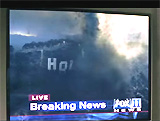 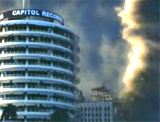 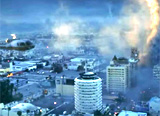 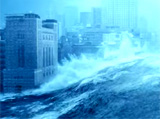 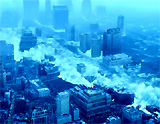 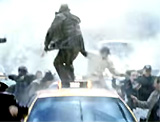 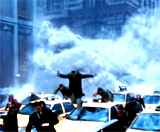
|
||||||||||||||||||||||
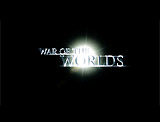
|
War of the Worlds (2005) The definitive Martian alien-invasion film was producer George Pal's and director Byron Haskin's film version of H. G. Wells' 1898 story - The War of the Worlds (1953), with Oscar-winning Special Effects by George Pal. With stars including Gene Barry and Ann Robinson, society fought off aliens who had invaded in manta ray-like space ships with cobra-like probes. The aliens zapped objects with deadly green disintegration rays that destroyed 1950s Los Angeles and set it afire. The monumental threat was forestalled only by their demise from minute bacterial agents. [Note: The film was overshadowed by Orson Welles' fear-inducing radio version in 1938.] The film's concepts were repeatedly copied afterwards, especially by the plot of Independence Day (1996) - and most memorably, the sci-fi film was remade as a spectacular Steven Spielberg-directed War of the Worlds (2005), an updated version with disaster film elements. It told about sinister attacking aliens in "Tripod" war machines from the perspective of divorced father Ray Ferrier (Tom Cruise) with two children in the New York area -- with haunting recollections of the 9/11 nightmare. New threats from the alien invaders included weapons that vaporized or instantly disintegrated (or incinerated) humans with rays from towering three-legged "Tripod" war machines (with force shields), or harvesting human blood and tissue as fertilizer to terra-form Earth. The ending wasn't much of a surprise if one had seen 1953 classic. The hatch was opened from a collapsed "Tripod", and a reddish liquid gushed from the circular entrance. First an elongated arm and hand, and then a sickly, struggling alien appeared - and immediately died. The film's narrator (Morgan Freeman) ponderously described, in the film's last lines, how the aliens would eventually be defeated:
|
 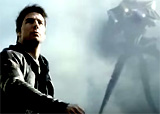 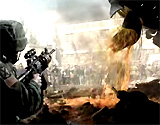 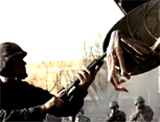 
|
||||||||||||||||||||||
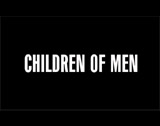
|
Children of Men (2006, UK/US) Director Alfonso Cuarón's bleak but visually-brilliant, apocalyptic science-fiction chase-thriller was set in the dystopic year 2027. England was repressive, fascist-run, terrorist-riddled, and in the midst of a civil war, as society was collapsing after two decades of human infertility. One of the main action sequences was a long and heroic journey to the utopian Human Project on the coast to protect a miraculously-pregnant woman, and the scene of a terrifying road-ambush scene. Civil servant and ex-activist Theo Faron (Clive Owen) was accompanied by estranged ex-lover/wife Julian Taylor (Julianne Moore), the leader of the insurgent underground Fishes revolutionary group. During the dangerous road-trip, Julian was shot in the neck and died shortly after. They were protecting African fugee (short for refugee) Kee (Claire-Hope Ashitey) who revealed to Theo her extended pregnant belly (the first pregnancy in the world in about 18 years). After assisting her in the birth of her baby girl in a crumbling, cold Bexhill apartment building in the refugee camp and internment center area, there was a most magical moment. Theo and Kee (with her crying baby in her arms) descended the stairs in the midst of a bloody siege and uprising (filmed continuously with a hand-held camera) surrounding the Bexhill apartment building - and the British soldiers and other combatants stood back momentarily in quiet awe. In the hopeful final scene, Theo (wounded during the skirmish) slumped over in a rowboat and died at the same moment that they reached the buoy rendezvous point with the Human Project's ship Tomorrow's appearance in the fog. Reportedly, the scientific group known as the 'Human Project', located in the Azores, was dedicated to curing infertility. |
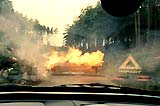  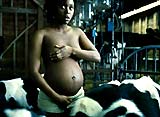 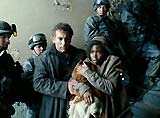 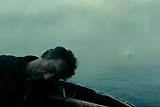
|
||||||||||||||||||||||

|
Poseidon (2006) Director Wolfgang Petersen's last directorial effort was this blockbuster remake of the original Irwin Allen disaster classic in 1972, ignoring the sequel:
ILM's special effects department was nominated for an Academy Award for Best Visual Effects (losing to Pirates of the Caribbean: Dead Man's Chest (2006)). It also received a Razzie nomination for Worst Remake or Rip-Off (losing to Keenen Ivory Wayans' Littleman (2006)). In both stories, on New Years' Eve, the luxury liner MS Poseidon on its way to New York, capsized in the middle of the North Atlantic Ocean due to a 150 foot-tall rogue tidal wave. A small group attempted to make its way to safety in the upside-down craft, while avoiding drowning, potentially being crushed or falling, navigating through the twisted wreckage of the crippled ship, and possible electrocution. There were similarities between the original film and the remake in the number of the group of initial survivors (10), the number that made it to safety (6), and the method of demise (similar in four cases).
In the film's conclusion, the survivors (who had made their way out of the treacherous ocean liner) were in a life raft, and had to furiously row to avoid being sucked down into the whirlpool caused by the sinking ship. |
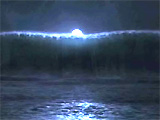 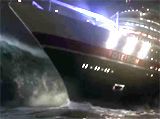 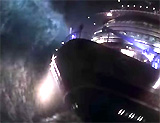 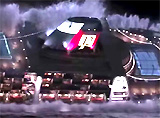 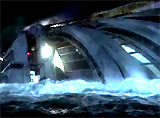 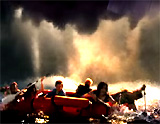 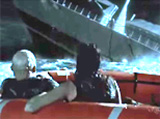 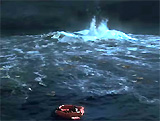
|
||||||||||||||||||||||
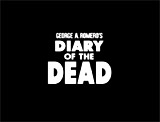
|
George Romero's low-budget "Dead" film, appeared within a long line of zombie films, with thematic disaster-film elements:
Told with a "film-within-a-film" framework, it began with conflicting and dubious news reports about how there was no clear reason for the chaos in the world, although there was speculation about some kind of germ or epidemic, or natural calamity, or even that everything was a massive hoax. It was obvious that political and social unrest had been unleashed, as a result of the zombie infestation. Student film-makers were interrupted while making a Blair Witch Project-like horror film, and they determinedly took their video cameras and other gadget-techno devices on the road to tell the real truth of the zombie attacks with their own first-person footage. The students believed the government was lying about the causes of the zombie resurrection, and vowed to show the world the truth of what had really happened. The documentary of the unexplainable zombie phenomenon (mostly with long takes and jerky hand-held digital video camera shots) was called The Death of Death. |
 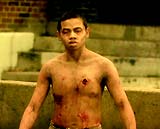
|
||||||||||||||||||||||
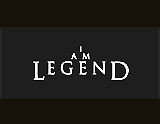
|
I Am Legend (2007) The previous two versions of the film (adaptations of Richard Matheson's 1954 novel) were:
The film's setting was now New York City in the year 2012, with only one survivor - ex-military scientist Dr. Robert Neville (Will Smith), a virologist. A man-made virus (a genetically-engineered cancer cure that mutated and became deadly) had virtually wiped out most of the global population three years earlier. By day with his trusted German shepherd Sam, Neville hunted and foraged throughout the starkly deserted and abandoned city (with cars left on the streets), avoiding the aggressive, zombified, vampirish, virus-infected mutant creatures or hemocytes (called DarkSeekers) that only emerged at night. His violent assailants were victims of the virus. Other dangers came from a pack of infected dogs. In the film's climax, he realized that he had found the cure for the virus (preserved in a vial of blood), while he was being attacked in a protective, plexi-glassed enclosure. To save two other survivors, Anna (Alice Braga) and her son Ethan (Charlie Tahan) and the human race, he pulled the pin on a hand grenade and charged at the attackers to sacrifice himself. His strategy killed off the infected leader Alpha Male (Dash Mihok) and all of the others in his laboratory basement. Major on-location sites in NYC included Times Square, Tribeca, and Washington Square, with one of the most spectacular scenes involving a fragmented Brooklyn Bridge (a $5 million dollar scene). |
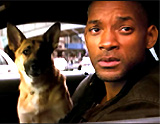 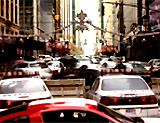 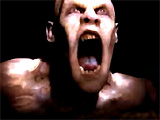  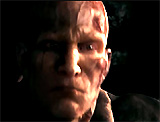 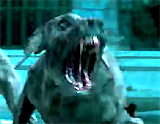 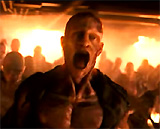
|
||||||||||||||||||||||

|
Cloverfield (2008) Director Matt Reeves' 'found-footage' action horror-thriller (his first feature film) was an American monster and disaster movie. The short 84 minute film was produced by J.J. Abrams (responsible for popular TV shows including Alias, Lost, Fringe, and Person of Interest). The tagline was:
It was hyped and advertised with a viral media campaign with lots of obscuring secrecy (with a '1-18-08' trailer). Many compared the film's events to the horrors experienced by New Yorkers during 9/11. Although a full franchise hasn't developed yet, the successor psychological thriller 10 Cloverfield Lane (2016) was set in the same universe. Critics lambasted the Godzilla-like, alien-attack film (similar to the pre 9/11 American remake of Godzilla (1998)) for its derivative nature, poor acting and script-writing. When the disaster film started with a color bars test pattern, it was presented as chilling and oblique video footage recovered by the US Department of Defense - the personal recording was located in an area known as US447 ("formerly known as Central Park"). Most of the video was filmed on the night of Friday, May 22, 2009 (and the next early morning). Its two main characters (in a cast of unknowns), both NYC residents, were:
There were many catastrophes in this film, most of which were caused by the appearance (slowly revealed) of a monstrous scaly creature with fireballs for breath (covered with superfast, vicious spider or crab-like parasites that fell off and attacked), who threatened the entire city. Disasters included the decapitation of the Statue of Liberty that landed in the street, and the destruction of the Brooklyn Bridge (by the monster's tail). The rescue operation was code-named Cloverfield. One of the scariest sequences was filmed in the pitch-black darkness of the Spring Street subway station, where a small group of 20-somethings was attacked by one of the crab-like creatures, and Marlena (Lizzy Caplan) suffered a lethal toxic bite on her shoulder, and later complained: "I don't feel so good" before dying. The helicopter carrying an injured Beth, Rob, and Hud (T.J. Miller), the camcorder operator, crashed in Central Park after being attacked by the Monster, wounding Hud before he was literally consumed by the beast. In the film's final moments, Beth and Rob awaited the destruction of the city. |
  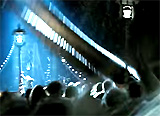  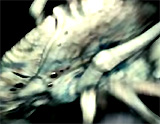 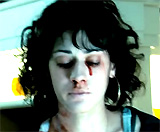 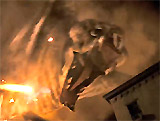 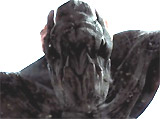
|
||||||||||||||||||||||

|
Knowing (2009) Alex Proyas' sci-fi action disaster thriller opened in the year 2009, with the reading of letters written by schoolchildren in 1959 (fifty years earlier), found in a Boston-area elementary school time capsule. The cryptic letter of sad, slightly-disturbed schoolgirl Lucinda Embry (Lara Robinson) had seemingly random numbers, deciphered as meaningful code by MIT astrophysics Professor John Koestler (Nicolas Cage). He guessed that a series of numbers, such as 911012996, referred to dates of worldwide disasters in the last 50 years, among them:
He then figured out that the numbers were in sequence by date, body count, and then GPS geographic positional coordinates (latitude and longitude). Koestler's son Caleb (Chandler Canterbury) also foretold, witnessed and envisioned a woodland wildfire consuming stampeding deer and moose. There were three more deadly events about to happen in the near future, and he experienced all of them:
The final number 33 was actually EE="everyone else" written backwards, signifying that there would be no survivors (everyone would die) on October 19, 2009. |
 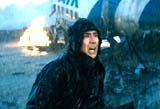 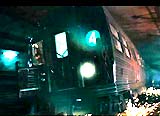   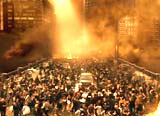 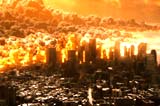
|
||||||||||||||||||||||

|
2012 (2009) This was another sci-fi disaster epic from end of days movie-expert Roland Emmerich, with ground-breaking special effects. It was based upon the Mayan calendar's apocalyptic predictions for the cataclysmic year 2012 (when the world would end on December 21st). The tagline referred to the Mayan prediction:
The viral campaign for the film was effective in spreading the word about the possibility of a doomsday natural disaster. This film followed Emmerich's other films:
In this end-of-the-world saga, divorced novelist and LA father Jackson Curtis (John Cusack) attempted to save his family (ex-wife Kate (Amanda Peet) and their children Noah (Liam James) and Lilly (Morgan Lily)) from a geological and meteorological disaster. Leaders around the world also began construction of gigantic "arks" in China to escape the impending cataclysm (each ark would hold 100,000 people). There were a series of environmentally-related catastrophic disasters, one leading to the next:
|
 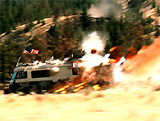 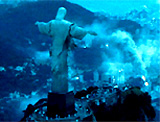 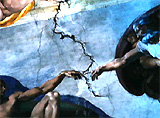 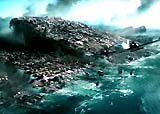  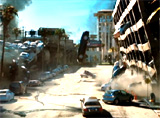 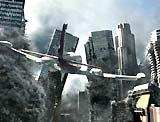 |
||||||||||||||||||||||